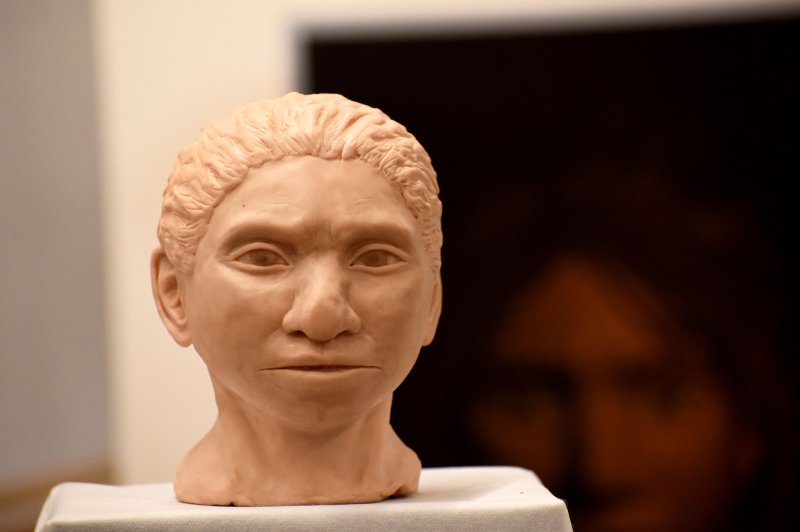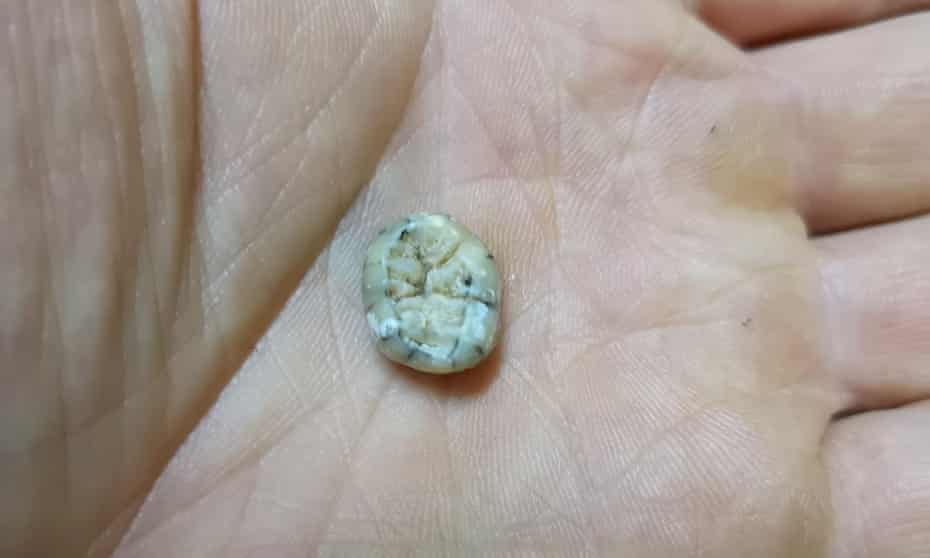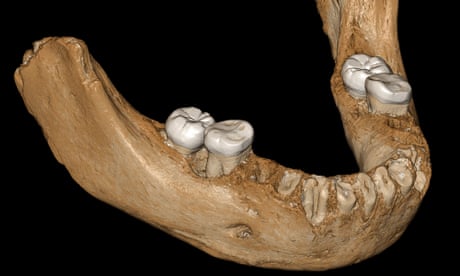
An ancient tooth found in southeast Asia links extinct Denisovans to modern day humans, according to findings published Tuesday in the journal Nature Communications. A close-up of the 3D printed reconstruction of a female Denisovan. File Photo by Debbie Hill/UPI | License Photo
May 17 (UPI) -- A fossilized tooth dug from a mountain cave in northern Laos is the first evidence to show the extinct human species, the Denisovans, lived in southeast Asia.
Scientists published their findings Tuesday in the journal Nature Communications and said the large ancient molar, found in Cobra Cave, appears to be from a young Denisovan girl who died between 164,000 and 131,000 years ago.
"We've always assumed that Denisovans were in this part of the world, but we've never had the physical evidence," said study co-author Laura Shackelford, a paleoanthropolotist at the University of Illinois Urbana-Champaign. "This is one little piece of evidence that they were really there."
RELATED Scientists use Neanderthal genes to grow tissue in a Petri dish
Denisovan teeth and finger bones were first discovered in Siberia and Tibet in 2010. DNA testing revealed these extinct hominids interbred with Neanderthals and modern humans, and are among the ancestors to current populations in Australia and the Pacific. But until now, scientists could not track the ancient species to the area.
Tuesday's published discovery of a Denisovan fossilized tooth in southeast Asia provides the geographical link between these ancient hominids and people living today.
It also shows the Denisovans occupied a wide range of areas and were able to adapt to different climates. It shows that 131,000 years ago the Denisovans could survive in temperate conditions as well as frigid temperatures, making them more similar to our own species.
RELATED Earliest evidence of hominin interbreeding revealed by DNA analysis
University of Toronto researcher Bence Viola said the molar was in the "right place and right time" to belong to a Denisovan. "In its size, it is comparable to hominins that lived two or three million years ago... but the age of it shows that it is very recent."
Scientists were convinced five years ago there were Denisovan fossils in southeast Asia.
"The genetic data shows that these guys were spread over large parts of Asia, so we must have them," Viola said in 2017.
Child’s 130,000-year-old tooth could offer clues to extinct human relative
Researchers believe the discovery in a Laos cave proves that Denisovans lived in the warm tropics of southeast Asia

Researchers believe the discovery in a Laos cave proves that Denisovans lived in the warm tropics of southeast Asia

A view of the molar thought to belong to a young female child from the extinct human species called the Denisovans, was found in cave Tam Ngu Hao in northeastern Laos.
Photograph: Fabrice Demeter/Reuters
Agence France-Presse
Photograph: Fabrice Demeter/Reuters
Agence France-Presse
Tue 17 May 2022
A child’s tooth at least 130,000 years old found in a Laos cave could help scientists uncover more information about an early human cousin, according to a new study.
Researchers believe the discovery proves that Denisovans – a now-extinct branch of humanity – lived in the warm tropics of southeast Asia.
Very little is known about the Denisovans, a cousin of Neanderthals.
Scientists first discovered them while working in a Siberian cave in 2010 and finding a finger bone of a girl belonging to a previously unidentified group of humans.
Using only a finger and a wisdom tooth found in the Denisova Cave, they extracted an entire genome of the group.
Researchers then found a jawbone in 2019 on the Tibetan Plateau, proving that part of the species lived in China as well.
Aside from these rare fossils, the Denisovans left little trace before disappearing – except in the genes of human DNA today.
Through interbreeding with Homo sapiens, Denisovan remnants can be found in current populations in southeast Asia and Oceania.
Aboriginal Australians and people in Papua New Guinea have up to five percent of the ancient species’ DNA.
Scientists concluded “these populations’ modern ancestors were ‘mixed’ with Denisovans in southeast Asia”, said Clement Zanolli, a paleoanthropologist and co-author of the study published Tuesday in Nature Communications.
But there was no “physical proof” of their presence in this part of the Asian continent, far from the freezing mountains of Siberia or Tibet, the researcher at the French National Centre for Scientific Research told AFP.
This was the case until the group of scientists began searching in the Cobra Cave in northeast Laos.
Cave specialists discovered the area in a mountain in 2018 next to Tam Pa Ling Cave, where the remains of ancient humans have already been found.
The tooth immediately appeared to have a “typically human” shape, explained Zanolli.
The study said, based on ancient proteins, the tooth belonged to a child, likely female, aged between 3.5 and 8.5 years old.
But the tooth is too old for carbon-dating, and the DNA has been badly preserved because of heat and humidity, said paleoanthropologist and study co-author Fabrice Demeter.
After analysing the shape of the tooth, scientists reckon it was most likely a Denisovan who lived between 164,000 to 131,000 years ago.
They then studied the tooth’s interior through different methods including analysing proteins and a 3D X-ray reconstruction.

'Spectacular' jawbone discovery sheds light on ancient Denisovans
The tooth’s internal structure was similar to that of the molars found in the Tibetan Denisova specimen. It was clearly distinguishable from modern humans and other ancient species that lived in Indonesia and the Philippines.
“The proteins allowed us to identify the sex – female – and confirm its relation to the Homo species,” said Demeter, a researcher at the University of Copenhagen in Denmark, where the tooth is temporarily based.
The tooth’s structure had common characteristics with Neanderthals, who were genetically close to Denisovans. The two species are thought to have diverged about 350,000 years ago.
But Zanolli explained that the researchers concluded it was a Denisova specimen because no Neanderthal traces have been found so far east.
For Demeter, the discovery shows that Denisovans occupied this part of Asia and adapted to a wide range of environments, from cold altitudes to tropical climates, whereas their Neanderthal cousins seemed more “specialised” in cold western regions.
The last Denisovans could have therefore met and interbred with modern humans, who passed on their genetic heritage to southeast Asia’s modern populations, in the Pleistocene epoch.
A child’s tooth at least 130,000 years old found in a Laos cave could help scientists uncover more information about an early human cousin, according to a new study.
Researchers believe the discovery proves that Denisovans – a now-extinct branch of humanity – lived in the warm tropics of southeast Asia.
Very little is known about the Denisovans, a cousin of Neanderthals.
Scientists first discovered them while working in a Siberian cave in 2010 and finding a finger bone of a girl belonging to a previously unidentified group of humans.
Using only a finger and a wisdom tooth found in the Denisova Cave, they extracted an entire genome of the group.
Researchers then found a jawbone in 2019 on the Tibetan Plateau, proving that part of the species lived in China as well.
Aside from these rare fossils, the Denisovans left little trace before disappearing – except in the genes of human DNA today.
Through interbreeding with Homo sapiens, Denisovan remnants can be found in current populations in southeast Asia and Oceania.
Aboriginal Australians and people in Papua New Guinea have up to five percent of the ancient species’ DNA.
Scientists concluded “these populations’ modern ancestors were ‘mixed’ with Denisovans in southeast Asia”, said Clement Zanolli, a paleoanthropologist and co-author of the study published Tuesday in Nature Communications.
But there was no “physical proof” of their presence in this part of the Asian continent, far from the freezing mountains of Siberia or Tibet, the researcher at the French National Centre for Scientific Research told AFP.
This was the case until the group of scientists began searching in the Cobra Cave in northeast Laos.
Cave specialists discovered the area in a mountain in 2018 next to Tam Pa Ling Cave, where the remains of ancient humans have already been found.
The tooth immediately appeared to have a “typically human” shape, explained Zanolli.
The study said, based on ancient proteins, the tooth belonged to a child, likely female, aged between 3.5 and 8.5 years old.
But the tooth is too old for carbon-dating, and the DNA has been badly preserved because of heat and humidity, said paleoanthropologist and study co-author Fabrice Demeter.
After analysing the shape of the tooth, scientists reckon it was most likely a Denisovan who lived between 164,000 to 131,000 years ago.
They then studied the tooth’s interior through different methods including analysing proteins and a 3D X-ray reconstruction.

'Spectacular' jawbone discovery sheds light on ancient Denisovans
The tooth’s internal structure was similar to that of the molars found in the Tibetan Denisova specimen. It was clearly distinguishable from modern humans and other ancient species that lived in Indonesia and the Philippines.
“The proteins allowed us to identify the sex – female – and confirm its relation to the Homo species,” said Demeter, a researcher at the University of Copenhagen in Denmark, where the tooth is temporarily based.
The tooth’s structure had common characteristics with Neanderthals, who were genetically close to Denisovans. The two species are thought to have diverged about 350,000 years ago.
But Zanolli explained that the researchers concluded it was a Denisova specimen because no Neanderthal traces have been found so far east.
For Demeter, the discovery shows that Denisovans occupied this part of Asia and adapted to a wide range of environments, from cold altitudes to tropical climates, whereas their Neanderthal cousins seemed more “specialised” in cold western regions.
The last Denisovans could have therefore met and interbred with modern humans, who passed on their genetic heritage to southeast Asia’s modern populations, in the Pleistocene epoch.
No comments:
Post a Comment